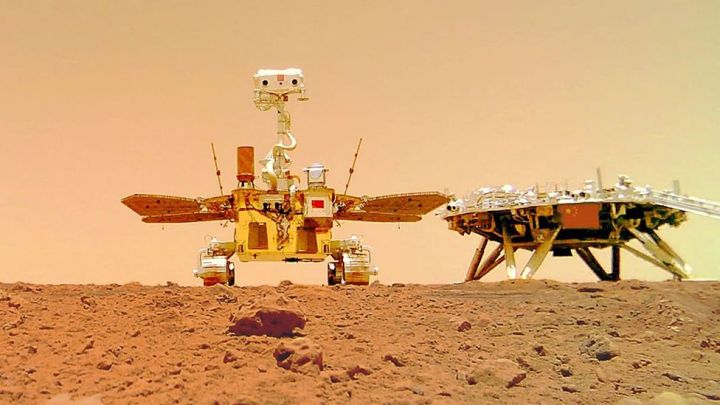
The China National Space Administration (CNSA) has shared new images of its Zhurong rover on the surface of Mars. Zhurong, which has been on the martian surface since last month, is named after a traditional Chinese fire god to match the Chinese name for Mars, Huoxing, which means planet of fire.
The image above shows the rover on the left, next to the lander that carried it to the surface of the planet. The rover is fully deployed on the surface, having rolled off the platform last month. The image was taken with a remote wireless camera, placed several meters away by the rover. The rover then rolled back into position to take this selfie photo.
The Zhurong rover is smaller than the other rovers currently exploring Mars, NASA’s Curiosity and Perseverance. Those rovers are around the size of a small car each, while Zhurong is less than 2 meters high. The image also shows that Zhurong has deployed its solar panels, which are used to collect power from the sun. The NASA rovers, by contrast, use nuclear power instead of solar.
Below is another photo released along with the rover selfie. It shows the lander and was taken after the rover had been deployed onto the surface. You can see the rover’s tracks in front of the lander to the right in the image.

The Zhurong rover was also recently captured from an entirely different angle. NASA’s orbiting Mars Reconnaissance Orbiter (MRO), which takes photos of the martian surface using its High Resolution Imaging Experiment (HiRISE) camera, passed over the rover’s landing site in the southern Utopia Planitia region and took a photo that showed the landing area from above.
Now, Zhurong will continue its mission, which aims to examine the composition of the martian surface and to look for evidence of ice water deposits. It will use its six instruments, including radar apparatus, a magnetometer, a weather instrument suite, a combination spectrometer, and two cameras. The mission is planned to last 90 sols, or 90 Mars days, which are just over 24 hours in length.



